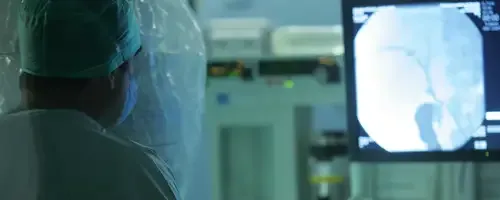Malformaciones vasculares
"La escleroterapia en microespuma está especialmente indicada en las malformaciones vasculares venosas y en las mixtas de predominio venoso o bajo flujo".
DR. ALEJANDRO SIERRA MARTÍNEZ
RESPONSABLE. ÁREA DE FLEBOLOGÍA

Las malformaciones vasculares son lesiones benignas (no cancerosas), presentes siempre desde el nacimiento, pero que a veces no son visibles hasta semanas o meses después.
La incidencia es igual en mujeres que en hombres.
Dependiendo si la malformación vascular es arterial o venosa, las implicaciones pueden variar y las complicaciones que presenta el paciente pueden ser simplemente estéticas a causar un problema importante para la salud.

¿Cuáles son los síntomas de las malformaciones vasculares?
Las malformaciones vasculares causarán síntomas en función de su gravedad y afectación vascular.
Puede manifestarse como una mancha en la piel que aumenta durante el crecimiento del niño y más tarde, se estabiliza.
Si la malformación vascular es muy grande o afecta a órganos importantes puede comprometer la calidad de vida de los pacientes, aumentando el riesgo de sangrado o incluso, afectando la funcionalidad del órgano comprometido.
Los síntomas más habituales son:
- Manchas rojo-violáceas en la piel.
- Riesgo de hemorragia.
¿Tiene alguno de estos síntomas?
Puede que presente una malformación vascular
¿Cómo se diagnostican las malformaciones vasculares?

El diagnóstico de las malformaciones vasculares es fundamentalmente clínico, basado en una correcta anamnesis y una minuciosa exploración física. Lo primero es saber si la lesión es congénita y de crecimiento muy lento.
Ante lesiones dudosas, está indicado realizar una biopsia con inmunohistoquímica para el anticuerpo GLUT-1, específico de hemangiomas.
Entre las pruebas de imagen, de primera elección suele utilizarse la ecografía-Doppler que permite diferenciar si la lesión es de alto o bajo flujo y distinguir si se trata de un hemangioma o una malformación vascular.
En función del tipo de lesión, localización y grado de afectación puede ser preciso realizar una radiografía, resonancia magnética, flebografía, angio-resonancia, arteriografía o linfoescintigrafía para completar el estudio.
¿Cómo se tratan las malformaciones vasculares?
Las malformaciones vasculares deben tratarse en la medida de las posibilidades, teniendo en cuenta el tipo de lesión, la localización y su profundidad.
Las lesiones pequeñas y superficiales habitualmente podrán tratarse con láser con una mejoría casi total.
En las lesiones extensas y profundas el tratamiento resulta complejo, siendo prácticamente imposible su erradicación en la mayoría de los casos.
La escleroterapia consiste en la inyección de un producto químico líquido en el interior de un vaso sanguíneo, de modo que al contactar éste con las paredes del vaso (las células endoteliales) produzca su oclusión o colapso.
Estos vasos pueden ser de diferentes tamaños, desde telangiectasias o vénulas de pequeño calibre, hasta varices o grandes flebectasias.
La eficacia de la esclerosis depende del diámetro o calibre del vaso y del flujo sanguíneo. A mayor calibre o mayor flujo, mayor dificultad de contacto entre el esclerosante y las células endoteliales de la pared vascular y, por tanto, menor eficacia.
¿Dónde la tratamos?
EN NAVARRA Y MADRID
El Servicio de Cirugía Vascular
de la Clínica Universidad de Navarra
El Servicio de Cirugía Vascular de la Clínica cuenta con tecnología de última generación para el diagnóstico, tratamiento y cirugía de patologías vasculares. Nuestra amplia experiencia, enmarcada en el entorno de calidad asistencial de la Clínica Universidad de Navarra, permite ofrecer al paciente los tratamientos más eficaces e innovadores.
Contamos con un quirófano especializado en cirugía vascular, dotado de un equipamiento avanzado para el tratamiento quirúrgico de las enfermedades vasculares más importantes.
Somos pioneros en braquiterapia endovascular, radioterapia localizada para tratar tumores, que se ha practicado en el mundo en muy pocas ocasiones.
Enfermedades que tratamos
- Enfermedades de la aorta.
- Enfermedades de las carótidas.
- Insuficiencia venosa crónica (varices).
- Isquemia de extremidades inferiores.
- Úlceras varicosas.

¿Por qué en la Clínica?
- En menos de 24 horas podemos realizar las pruebas necesarias para establecer el diagnóstico y el planteamiento del tratamiento.
- Área de Flebología pionera en España en el tratamiento de varices con microespuma.



